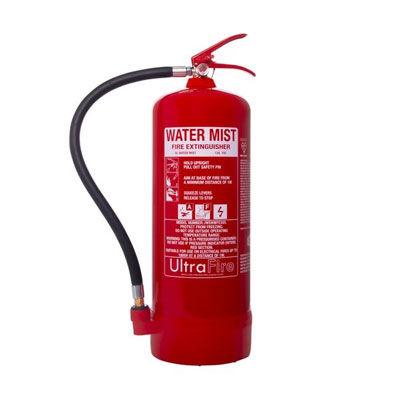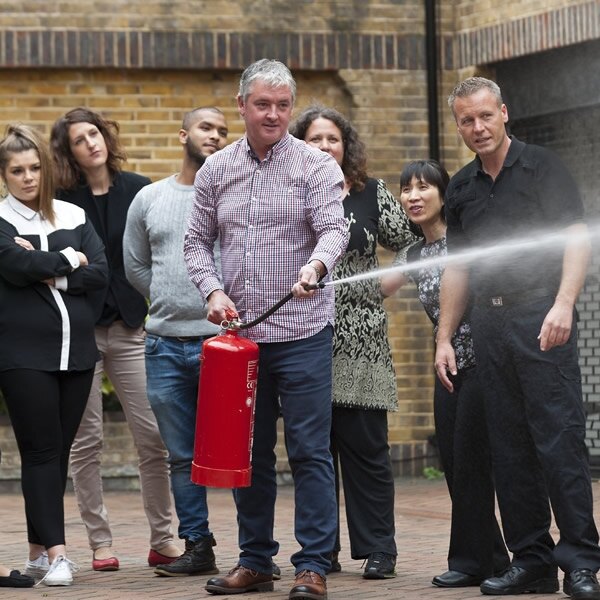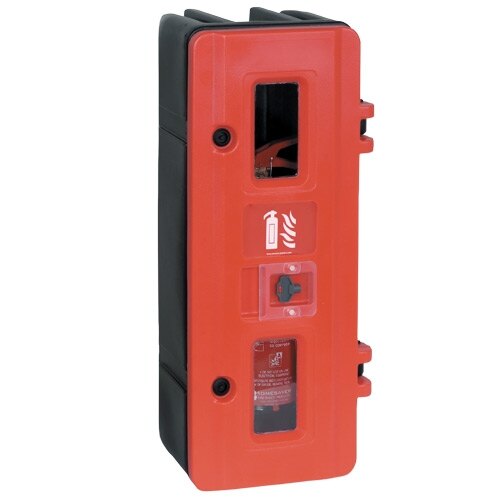-
Contact
Sales & Customer Service
0800 612 6537 support@safelincs.co.uk Live ChatDelivery Enquiries
0800 077 6149 - Resources
Fire & Safety Solutions
CALL OUR TEAM NOW 0800 612 6537
Lines open today 8am - 6pm
Free Delivery
on 100s of Products
Live Chat - Online
Instant help & Advice
Trade Discounts
and exclusive pricing
0% Credit Available
Open an account now
5 Star Customer Feedback
Fire Extinguishers for schools
Make sure you have got school fire extinguishers covered with our help guide. All your most frequently asked questions answered and money saving advice for schools. This guide gives general advice, but you should always refer to your fire risk assessment for advice specific to your circumstances.

How many fire extinguishers are needed in a school?
The number of fire extinguishers needed in any school or college will depend on the specific fire risk present and should be determined by the school’s Fire Risk Assessment as set out in the Regulatory Reform (Fire Safety) Order 2005. Your school fire risk assessment should be reviewed regularly, particularly if parts of the building have changed use.
Where should fire extinguishers be positioned in schools?
Fire extinguishers should be easily accessible in an emergency. They need to be sited in an obvious place where they can be clearly seen. It is good practice to position fire extinguishers in escape routes or near exits so that people move towards the exit to locate them rather than further into the school building.
Fire extinguishers must be positioned near the potential fire hazards, but not so close that it would be difficult to get to them if a fire broke out. Mount fire extinguishers on the wall using a wall bracket or cabinet, or alternatively store them in a floor-standing fire extinguisher stand.
What are the most likely causes of fire in schools?
According to the Home Office Fire Statistics, Fire Rescue Services in England were called to nearly 2000 school fires between 2017 and 2020. The leading causes of fires in schools were found to be faulty appliances, electrics, kitchen fires and arson.
Fire risks in schools could include (but are not limited to)
- Build-up of combustible material such as paper or wood (this could be in a wheelie bin or skip)
- Overloaded plug sockets or extension cables
- Faulty appliances or heating
- Cooking fires
- Combustible materials such as chemicals or hazardous substances
Your school fire risk assessment should take into account any potential fire hazards, and clear measures to reduce the risk should be implemented.
What type of fire extinguishers are best for schools?
The type of fire extinguisher needed in your school will depend on the fire risks detailed in your fire risk assessment. Follow our general guide below for advice on choosing the right fire extinguisher for each specific school fire risk:
| Location | Common Fire Risks | Classes of Fire | Suitable Extinguisher |
|---|---|---|---|
| Corridors & stair wells (also covering general classrooms) | Electrical devices, electrics, solid combustibles like paper & wood, plastics |
Class A & electrical |
Or |
| Laboratories, technology and art classrooms | Electrics, flammable substances (liquids and gases), solid combustibles, plastics |
Class A, B, C & electrical |
Or Fire blanket |
| Kitchens | Deep fat fryers, electrical equipment, gas |
Class A, B, C, Electrical |
Or
|
|
Class F |
|
||
| Boiler rooms | Oil fuel |
Class B |
Powder extinguisher |
| IT classrooms, areas with stage lighting | Electrical equipment, lighting, computers |
Electrical |
Water Mist |
| Server rooms | Electrical equipment |
Electrical |
Or |
*CO2 extinguishers have traditionally been recommended for tackling electrical fires, especially in server rooms where damage to equipment would be devastating. The risk to humans from asphyxiation from concentrated carbon dioxide is a problem, particularly in confined areas and they should only be used in exceptional circumstances.
Which fire extinguisher is best for tackling general fire risks?
Water Mist Extinguishers are ideal for tackling general fire risks in school environments.

Why choose water mist extinguishers?
- Leaves no messy residue or moisture to clean up
- Water Mist does not damage equipment when discharged
- Versatile extinguisher – can put out a wide range of common fires including electrical fires
- Environmentally friendly - contains only fine de-ionised water droplets; contains no chemicals
- Non-toxic
- Recyclable after use
If you are looking for a low-maintenance and cost-effective solution, P50 Water Mist Service-Free Extinguishers are a great option for tackling general fire risks across all parts of the school. P50 fire extinguishers can save you up to 50% on fire extinguisher and maintenance costs as they require no annual servicing by a trained technician. They can instead be inspected each year by a member of your team. P50 extinguishers last for 10 years before they require refurbishment and they are incredibly durable.
If you are interested in finding out more about P50 Water Mist Service-Free Extinguishers, why not book a free site survey with a member of our team?
What maintenance is required for school fire extinguishers?
It is essential that fire extinguishers are maintained so that they are ready for use in an emergency. This is the responsibility of the School Fire Safety Officer. Traditional steel extinguishers such as foam, water mist or CO2 require annual servicing from a qualified engineer. Our extinguisher servicing reminders are a useful tool to ensure servicing is not forgotten.
P50 Service-Free Fire Extinguishers do not require annual servicing from a trained engineer. They can instead be inspected each year by a member of your staffing team who has been trained on the P50 3-step inspection process.
It is important to check whether your fire extinguishers need refilling, refurbishing or replacing. For further help, read our article 'How Old Is Your Fire Extinguisher?'
How do I save money on school fire extinguishers?
Switching to P50 Service-free Extinguishers is a great way to cut your fire extinguisher costs. P50 Extinguishers can be serviced each year by a trained member of your staff rather than by a qualified engineer. The simple 3-step inspection process is easy to carry out and means that there is no outlay each year for servicing from an external contractor. P50 extinguishers also last twice as long as traditional extinguishers, only requiring a manufacturer refurbishment after 10 years. After this refurbishment, they will last another 10 years, giving a total of 20 years of service, compared to 10-12 years with a traditional extinguisher.
Due to their versitility, one P50 Water Mist can often be used to replace a traditional CO2 and Water/foam extinguisher combination. This has the potential to significantly reduce the number of fire extinguishers you require on your school site, in turn saving you even more money. Our team can visit your site to carry out a free site survey and advise on the savings that could be made.
When you switch to P50 Service-Free Extinguishers, you will receive free delivery and installation by our certified engineers. The engineers will also remove old extinguisher units from your site. You will also receive free training for staff members on the annual inspection, certification and included wall signage. Call 0800 612 6537 or email support@safelincs.co.uk to find out more.
Is fire extinguisher training required for staff?
Staff fire safety training is critical so that they can act swiftly and confidently in an emergency. It is a legal requirement for employers to provide those working in schools with appropriate fire safety training. Our group training sessions can be done at your school and can be tailored to relevant fire risks in your environment.
Other training courses are also available.

 How should fire extinguishers be stored in schools?
How should fire extinguishers be stored in schools?
Fire extinguishers in busy areas such as corridors could be damaged accidently and are more likely to be vandalised. Protect fire extinguishers in your school by keeping them in a locked or alarmed extinguisher cabinet. The durable Jonesco Fire Extinguisher Cabinet has a key lock and alarm. They key is stored securely behind glass. When the glass is broken to release the key, an alarm sounds.
Alternatively, consider purchasing a fire extinguisher anti-theft device which sounds an alarm when the extinguisher is removed from the wall bracket or when the extinguisher is activated.
FAQs
Are fire extinguishers required as well as sprinklers?
Your fire risk assessment should detail whether a sprinkler system and/or fire extinguishers are required. Whilst sprinkler systems are very effective in controlling and extinguishing an established fire, a fire extinguisher can help to tackle small fires immediately. Fire extinguishers can be useful for managing risks in science labs or kitchens for example. Sprinkler systems may not detect the small fire at this early stage and so a fire extinguisher will allow for more immediate action before a small fire spreads. This in turn is likely to limit any further fire damage and water damage from sprinklers.
Reviewed: 10/11/2023 (doc:564 V1.1). Our articles are reviewed regularly. However, any changes made to standards or legislation following the review date will not have been considered. Please note that we provide abridged, easy-to-understand guidance. To make detailed decisions about your fire safety provisions, you might require further advice or need to consult the full standards and legislation.
























